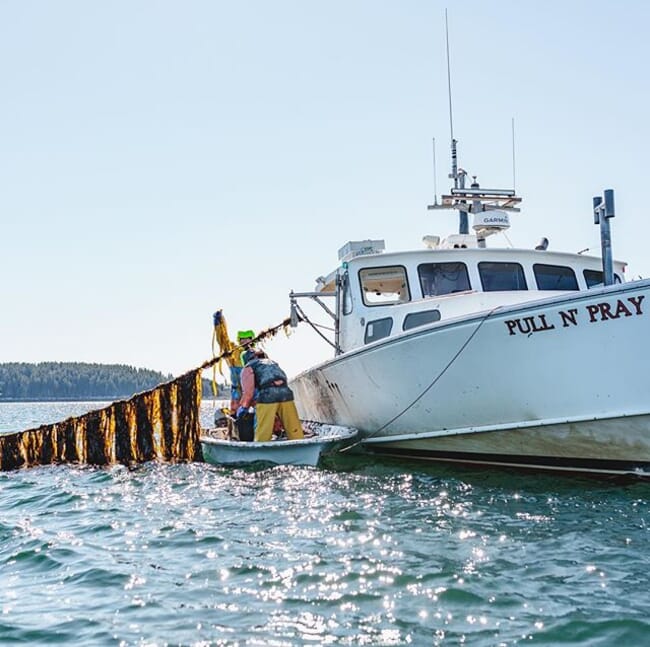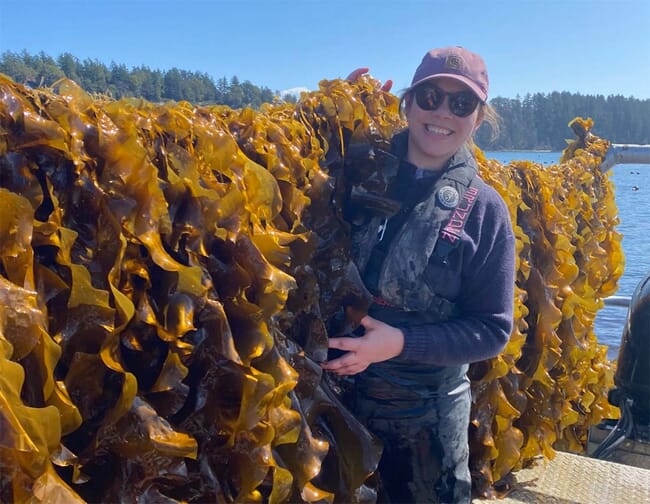
© Atlantic Sea Farms
In 2018, the total kelp harvest in the United States was 50,000 pounds. In 2024, Maine alone harvested 1.4 million pounds. Other states and provinces are looking to get in on this action as well, including the three Pacific Northwest entities collectively known as Cascadia: Alaska, British Columbia and Washington.
Yet even Maine’s exponential increase in harvest is a tiny fraction of global seaweed production, which stood at over 30 million tonnes in 2022. Despite some recent successes from startup companies such as Maine’s Atlantic Sea Farms and British Columbia’s Cascadia Seaweed, limited market development and lack of investment have combined to prevent real breakthrough growth of this industry in North America.
To begin addressing these challenges, last year Upwell Collaborative and Transformational Investing in Food Systems (TIFS) held a series of four roundtable discussions on aquaculture investing. Taking input from all parts of the seaweed industry spectrum – growers, processors, regulators, end users, non-profit organisations, community and Indigenous leaders, researchers, entrepreneurs and financiers – we learned that there are a few key choke points preventing growth in this industry, all of which are interrelated and require coordinated solutions.
Would-be growers are often constrained by permitting processes and access to leases. This contributes to instability in the supply chain. So even end users – manufacturers of things like biostimulants, or feed products, or pharmaceuticals and beauty products – who might be inclined to pivot to a domestically-sourced, sustainable product like seaweed can’t do so if the cost is too high and the supply is uncertain.
This is compounded by a lack of investment in growing and processing operations. Due to a lack of market predictability, investors are loath to pull the trigger on large scale commitments for individual farms, or cooperatives, or processing facilities that could provide a more consistent supply of product and begin to stabilise the market. And the regulatory process is often further complicated by outdated narratives including a perception that more ocean farming would adversely affect other ocean industries, such as commercial fishing, or become undesirable to coastal property owners.

© Cascadia Seaweed
TIFS describes itself as “an impact network of investors, funders, intermediaries, and enterprises building a market for a regenerative, equitable, and climate-resilient food future.” This circular series of challenges leads to an example of a problem that it has described in its work on agriculture finance as the “missing middle.” They define this as “the gap between available capital and investable opportunities in Indigenous, agroecological, and regenerative food systems.”
Their work in this space has been revolutionary. For example, in 2024 alone, it contributed to the creation of a $1.2 billion project to scale an agroforestry palm oil system in Brazil and supported a $120 million boost to a natural farming project in India.
TIFS’s track record represents a pathway that they and Upwell now envision for the seaweed farming industry in North America. As our organisations continue to build this work in partnership with Hatch Blue’s consulting arm, we will dive deeper into these conversations with key players from across the spectrum, emerging with analyses, designs and action plans to resolve this missing middle problem and infuse momentum into mariculture.
Our goal is to chart a path for investors to drive growth at the speed of kelp in an industry that has the potential to simultaneously create economic opportunities in remote coastal communities, contribute to healthier ocean ecosystems and improve the environmental footprint of a wide range of everyday products.
We welcome additional input, stories of on-the-ground and in-the-water experiences, and requests for more information. To learn more about our work or to be considered for participation in future events and convenings, please reach out to us at Upwell Collaborative.
Mike Conathan is a co-founder and managing director of Upwell Collaborative. He has nearly two decades of experience in ocean policy and development of the blue economy, and lives in Portland, Maine.

© Ocean's Balance




